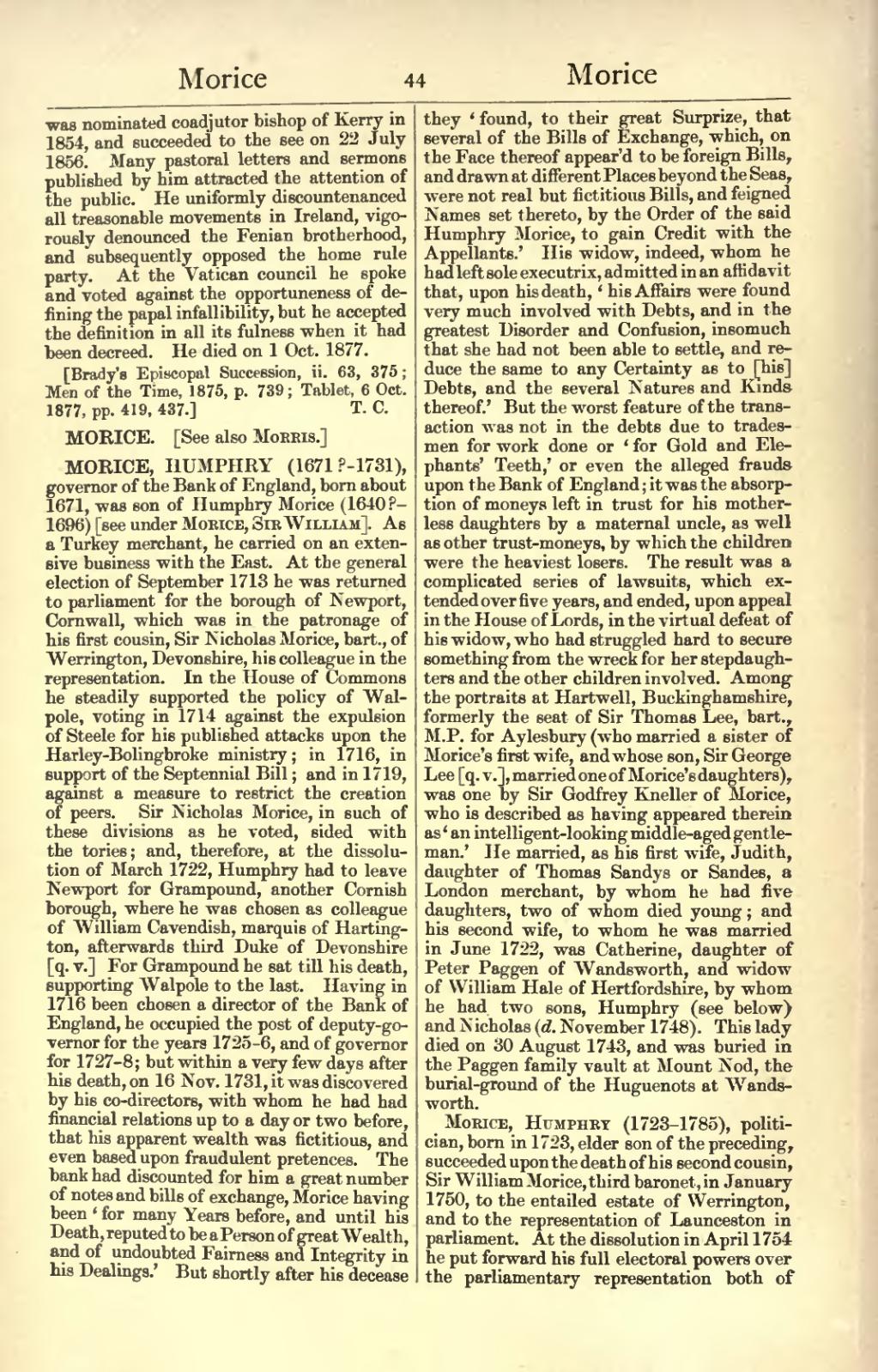was nominated coadjutor bishop of Kerry in 1854, and succeeded to the see on 22 July 1856. Many pastoral letters and sermons published by him attracted the attention of the public. He uniformly discountenanced all treasonable movements in Ireland, vigorously denounced the Fenian brotherhood, and subsequently opposed the home rule party. At the Vatican council he spoke and voted against the opportuneness of defining the papal infallibility, but he accepted the definition in all its fulness when it had been decreed. He died on 1 Oct. 1877.
[Brady's Episcopal Succession, ii. 63, 375 ; Men of the Time, 1875, p. 739; Tablet, 6 Oct. 1877, pp. 419, 437.]
MORICE. [See also Morris.]
MORICE, HUMPHRY (1671?–1731), governor of the Bank of England, born about 1671, was son of Humphry Morice (1640?-1696) [see under Morice, Sir William]. As a Turkey merchant, he carried on an extensive business with the East. At the general election of September 1713 he was returned to parliament for the borough of Newport, Cornwall, which was in the patronage of his first cousin, Sir Nicholas Morice, bart., of Werrington, Devonshire, his colleague in the representation. In the House of Commons he steadily supported the policy of Walpole, voting in 1714 against the expulsion of Steele for his published attacks upon the Harley-Bolingbroke ministry; in 1716, in support of the Septennial Bill; and in 1719, against a measure to restrict the creation of peers. Sir Nicholas Morice, in such of these divisions as he voted, sided with the tories; and, therefore, at the dissolution of March 1722, Humphry had to leave Newport for Grampound, another Cornish borough, where he was chosen as colleague of William Cavendish, marquis of Hartington, afterwards third Duke of Devonshire [q. v.] For Grampound he sat till his death, supporting Walpole to the last. Having in 1716 been chosen a director of the Bank of England, he occupied the post of deputy-governor for the years 1725-6, and of governor for 1727-8; but within a very few days after his death, on 16 Nov. 1731, it was discovered by his co-directors, with whom he had had financial relations up to a day or two before, that his apparent wealth was fictitious, and even based upon fraudulent pretences. The bank had discounted for him a great number of notes and bills of exchange, Morice having been 'for many Years before, and until his Death, reputed to be a Person of great Wealth, and of undoubted Fairness and Integrity in his Dealings.' But shortly after his decease they 'found, to their great Surprize, that several of the Bills of Exchange, which, on the Face thereof appear'd to be foreign Bills, and drawn at different Places beyond the Seas, were not real but fictitious Bills, and feigned Names set thereto, by the Order of the said Humphry Morice, to gain Credit with the Appellants.' His widow, indeed, whom he had left sole executrix, admitted in an affidavit that, upon his death, 'his Affairs were found very much involved with Debts, and in the greatest Disorder and Confusion, insomuch that she had not been able to settle, and reduce the same to any Certainty as to [his] Debts, and the several Natures and Kinds thereof.' But the worst feature of the transaction was not in the debts due to tradesmen for work done or 'for Gold and Elephants' Teeth,' or even the alleged frauds upon the Bank of England; it was the absorption of moneys left in trust for his motherless daughters by a maternal uncle, as well as other trust-moneys, by which the children were the heaviest losers. The result was a complicated series of lawsuits, which extended over five years, and ended, upon appeal in the House of Lords, in the virtual defeat of his widow, who had struggled hard to secure something from the wreck for her stepdaughters and the other children involved. Among the portraits at Hartwell, Buckinghamshire, formerly the seat of Sir Thomas Lee, bart. M.P. for Aylesbury (who married a sister of Morice's first wife, and whose son, Sir George Lee [q.v.], married one of Morice's daughters), was one by Sir Godfrey Kneller of Morice, who is described as having appeared therein as 'an intelligent-looking middle-aged gentleman.' He married, as his first wife, Judith, daughter of Thomas Sandys or Sandes, a London merchant, by whom he had five daughters, two of whom died young; and his second wife, to whom he was married in June 1722, was Catherine, daughter of Peter Paggen of Wandsworth, and widow of William Hale of Hertfordshire, by whom he had. two sons, Humphry (see below) and Nicholas (d. November 1748) . This lady died on 30 August 1743, and was buried in the Paggen family vault at Mount Nod, the burial-ground of the Huguenots at Wandsworth.
Morice, Humphrey (1723-1785), politician, born in 1723, elder son of the preceding, succeeded upon the death of his second cousin, Sir William Morice, third baronet, in January 1750, to the entailed estate of Werrington, and to the representation of Launceston in parliament. At the dissolution in April 1754 he put forward his full electoral powers over the parliamentary representation both of
